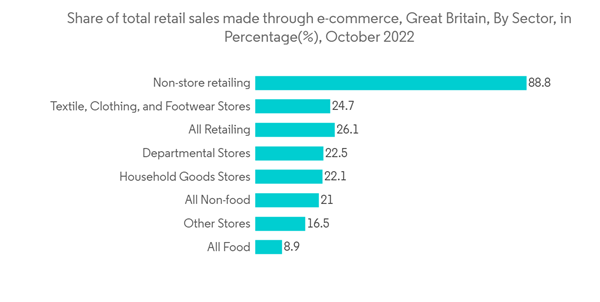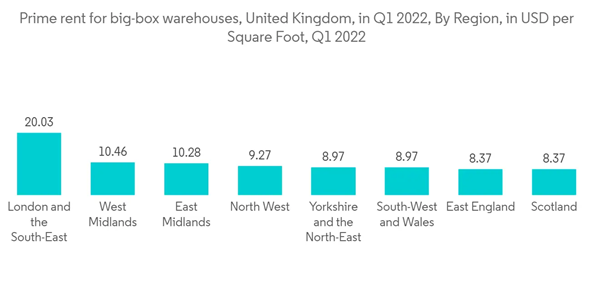The Global 3PL Market size is estimated at USD 1.29 trillion in 2024, and is expected to reach USD 1.68 trillion by 2029, growing at a CAGR of 5.48% during the forecast period (2024-2029).
The market is driven by the order fulfillment services and end-to-end pickup and delivery services provided by the players in the market. Furthermore, the market is driven by advanced technology, which is a cutting-edge factor for players to grow in the market.
E-commerce shippers are increasingly turning to 3PL providers to help them meet changing customer expectations and deal with supply chain disruption, labor constraints, transportation issues, inflation, and other challenges that have become the "new normal" in today's operating environment. As a result, 3PLs are offering shippers strategic locations, more space to accommodate higher inventory volumes, and a wider range of delivery options. As the volume of returns has increased in the last year, e-commerce shippers want to work with 3PLs that can help customers with the returns process. Omni-channel logistics services are also in high demand, with automation serving as a critical component of e-commerce fulfillment processes.
The larger 3PLs have multiple e-commerce operations, such as Geodis, DHL, Ryder, and JD Logistics (in Asia), to name a few of the larger players. Smaller providers have followed suit and now offer e-commerce fulfillment as well. In most cases, these 3PLs have e-commerce fulfillment operations separate from their traditional business-to-business (B2B) warehousing operations. More 3PLs will be needed in the future to add value in the last mile of the supply chain, where getting large and bulky items from the final point of distribution to the customer's location remains a major challenge. Getting furniture, fitness equipment, and other large items to customers' doors requires extra planning, especially if they require quick delivery.
Quick commerce is being adopted by industries such as grocery, pharmaceuticals, and e-commerce. Companies and brands are replacing traditional business models and distribution channels with digital platforms to improve their delivery services by leveraging available technological advancements. This market is typically distinguished by delivery times of less than 20 minutes. The order size, value, and weight are typically small(er) and easily transported via two-wheelers, drones, or small vehicles. The 3PL, on the other hand, has already grown to become an important stakeholder in the supply chain network. With the growing demand for resource-backed fulfillment services, such as improved delivery management software, acute logistics optimization, and increased use of smaller warehouses in urban areas, reliance on 3PLs will only increase.
With delivery volumes increasing all over the world, particularly due to the rapid growth of eCommerce, supply firms are looking for innovative, cost-effective, and efficient approaches to last-mile delivery. This has resulted in investments and trials of cutting-edge technology such as driverless cars, delivery bots, and drones. Aurora (self-driving technology) from Amazon is a prime example.
This product will be delivered within 2 business days.
The market is driven by the order fulfillment services and end-to-end pickup and delivery services provided by the players in the market. Furthermore, the market is driven by advanced technology, which is a cutting-edge factor for players to grow in the market.
Key Highlights
- The logistics industry has undergone several rapid changes in recent years. The trends that began and accelerated in 2020 continued in 2021 and 2022, with increased demand for home delivery and higher consumer expectations than ever before. At the same time, 2022 presented its own set of challenges in terms of inflation, economic volatility, and ongoing supply chain disruptions. Despite the major disruptions of 2022, there are still many major trends that have continued (and will continue) unabated. Amazon, for example, increased its dominance by heavily investing in its in-house logistics capabilities.
- Nowadays, shippers want to make more data-driven decisions. As a result, 3PL firms must brace themselves for clients who expect analytics expertise. According to one recent study, 94% of shippers believe analytics are required to ensure complete and on-time order fulfillment and package visibility. 3PLs will increasingly need to focus on generating more analytical insights across their operations, for example, by establishing data science capabilities and teams to provide useful insights to their clients and internal teams. Strong data and clear strategies will assist third-party logistics providers in providing shippers with improved traceability and end-to-end visibility across the supply chain. Aside from collecting more data, businesses must prioritize cybersecurity and have data protection plans in place.
- The importance of last-mile delivery is well-known to logistics service providers. However, many people are unaware that final mile operations will be a game changer in the coming years. Last-mile deliveries have already dethroned price and product as key differentiators in shopper purchasing decisions. Last-mile delivery is critical for both retaining and acquiring new customers. Simply put, last-mile operations can make or break a company. This has been one of the most important logistics trends for several years, and it shows no signs of abating. More 3PL companies are working to reduce last-mile delivery distances by locating fulfillment hubs in more accessible locations, such as urban centers.
- Customer retention is one of the most difficult challenges in a highly competitive market, driving businesses to embrace greater picking efficiency, smart inventory management, and rapid replenishment of hot-selling items. The supply chain and logistics domains are being transformed by fast data and strong network connectivity. Warehouse management systems (WMS) of today have extensive computing power, large amounts of data storage, and the ability to connect to other critical applications such as enterprise resource planning (ERP) and customer relationship management (CRM). It is no longer enough to simply track shipments; businesses must optimize every step of the process, from raw materials to the production line, marketing, and delivery of the product to the end customer.
Third Party Logistics (3PL) Market Trends
Growth in E-commerce Sales Driving the Market
On the fulfillment front, all shippers have a set of performance metrics or key performance indicators (KPIs) to work toward. In today's fast-paced fulfillment environment, meeting these targets can be difficult, especially if fulfillment is not a core competency for the shipper. Knowing this, the third-party logistics (3PL) industry has stepped up its game, offering a broader portfolio of services to a broader range of customers. Once the domain of extremely high-volume operations, even small businesses selling clothing online recognize the value of outsourcing some or all of their fulfillment operations to a reputable third party. The e-commerce boom has prompted more businesses to investigate 3PL options.E-commerce shippers are increasingly turning to 3PL providers to help them meet changing customer expectations and deal with supply chain disruption, labor constraints, transportation issues, inflation, and other challenges that have become the "new normal" in today's operating environment. As a result, 3PLs are offering shippers strategic locations, more space to accommodate higher inventory volumes, and a wider range of delivery options. As the volume of returns has increased in the last year, e-commerce shippers want to work with 3PLs that can help customers with the returns process. Omni-channel logistics services are also in high demand, with automation serving as a critical component of e-commerce fulfillment processes.
The larger 3PLs have multiple e-commerce operations, such as Geodis, DHL, Ryder, and JD Logistics (in Asia), to name a few of the larger players. Smaller providers have followed suit and now offer e-commerce fulfillment as well. In most cases, these 3PLs have e-commerce fulfillment operations separate from their traditional business-to-business (B2B) warehousing operations. More 3PLs will be needed in the future to add value in the last mile of the supply chain, where getting large and bulky items from the final point of distribution to the customer's location remains a major challenge. Getting furniture, fitness equipment, and other large items to customers' doors requires extra planning, especially if they require quick delivery.
Investment in Advanced Technology Could Reduce Cost of End-to-end Logistics Globally
In a competitive and growing market, the last two years, 2020-22, have taught us that we must be both flexible and agile. In 2021, unprecedented growth in online retail was expected, particularly in direct-to-consumer services. The provision of omnichannel services, in which customers enjoy a unified shopping experience regardless of channel, is a major focus. This could be done in-store, online, on mobile, or through social media. Customers now expect a more seamless experience, lower prices, faster shipping, and a greater emphasis on sustainability. One of the most difficult challenges has been the extraordinary demand in the grocery and apparel segments, where one-day deliveries or less are becoming the norm. There was a global shortage of transport capacity and a limited supply of delivery drivers in 2021.Quick commerce is being adopted by industries such as grocery, pharmaceuticals, and e-commerce. Companies and brands are replacing traditional business models and distribution channels with digital platforms to improve their delivery services by leveraging available technological advancements. This market is typically distinguished by delivery times of less than 20 minutes. The order size, value, and weight are typically small(er) and easily transported via two-wheelers, drones, or small vehicles. The 3PL, on the other hand, has already grown to become an important stakeholder in the supply chain network. With the growing demand for resource-backed fulfillment services, such as improved delivery management software, acute logistics optimization, and increased use of smaller warehouses in urban areas, reliance on 3PLs will only increase.
With delivery volumes increasing all over the world, particularly due to the rapid growth of eCommerce, supply firms are looking for innovative, cost-effective, and efficient approaches to last-mile delivery. This has resulted in investments and trials of cutting-edge technology such as driverless cars, delivery bots, and drones. Aurora (self-driving technology) from Amazon is a prime example.
Third Party Logistics (3PL) Industry Overview
The Third-Party Logistics (3PL) Market is fragmented and highly competitive, with several large companies strategically forming alliances with mid-sized or small-sized companies to leverage their regional capabilities in logistics. Major regional players have been observed to venture into new regions, allowing the companies to improve their geographic reach. New competitors are entering the 3PL market with customized and industry-specific services. Some major players include Agility, CEVA Logistics, DB Schenker, and DHL. The 3PL players have been showing a willingness to partner with other players to reduce cost and leverage on mutual competitive advantage. Additionally, technology adoption has also helped reduce operational costs and improve efficiency.Additional Benefits:
- The market estimate (ME) sheet in Excel format
- 3 months of analyst support
This product will be delivered within 2 business days.
Table of Contents
1 INTRODUCTION
4 MARKET INSIGHTS AND DYNAMICS
5 MARKET SEGMENTATION
6 COMPETITIVE LANDSCAPE
Companies Mentioned (Partial List)
A selection of companies mentioned in this report includes, but is not limited to:
- Agility Logistics
- Ceva Logistics
- DB Schenker
- DHL
- Nippon Express
- Yusen Logistics
- Kerry Logistics
- CH Robinson
- AmeriCold Logistics
- FedEx Corporation
- Kuehne+Nagel Inc.
- MAERSK
- DSV
- Panalpina
- Geodis*
Methodology

LOADING...










